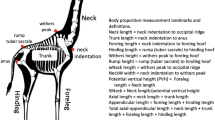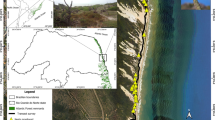Abstract
Although information concerning variation among and within populations is essential to understanding an organism's life history, little is known of such variation in any species of scorpion. We show that reproductive investment by the scorpion Centruroides vittatus varied among three Texas populations during one reproductive season. Females from the Kickapoo population produced smaller offspring and larger litters than females from the Independence Creek or Decatur populations; this pattern remained when adjusting for among population variation in either female mass or total litter mass. Relative clutch mass (RCM) and within-litter variability in offspring mass (V*) did not differ among populations. Among-population variation may result from genetic differences or from phenotypically plastic responses to differing environments. Within populations, the interrelationships among reproductive variables were similar for Decatur and Independence Creek: females investing more in reproduction (measured by total litter mass, TLM) produced larger litters and larger offspring, and V* decreased with increased mean offspring mass (and with decreased litter size at Decatur). At Kickapoo, larger females produced larger litters and had larger TLM; females investing more in reproduction produced larger litters but not larger offspring. Within litter variability in offspring mass was not correlated with any reproductive variables in this latter population. These patterns may be explained by the fractional clutch hypothesis, the inability of females precisely to control investment among offspring or morphological constraints on reproduction.
Similar content being viewed by others
References
Berven KA (1982) The genetic basis of altitudinal variation in the wood frog Rana sylvatica. I. An experimental analysis of life history traits. Evolution 36:962–983
Blueweiss L, Fox H, Kudzma V, Nakashima D, Peters R, Sams S (1978) Relationships between body size and some life history parameters. Oecologia 37:257–272
Bradley RA (1984) The influence of the quantity of food on fecundity in the desert grassland scorpion (Paruroctonus utahensis) (Scorpionida, Vaejovidae): an experimental test. Oecologia 62:53–56
Brockelman WY (1975) Competition, the fitness of offspring and optimal clutch size. Am Nat 109:677–699
Brodie ED III, Ducey PK (1989) Allocation of reproductive investment in the redbelly snake Storeria occipitomaculata. Am Midl Nat 122:51–58
Calow P (1983) Energetics of reproduction and its evolutionary implications. Biol J Linn Soc 20:153–165
Capinera JL (1979) Qualitative variation in plants and insects: effects of propagule size on ecological plasticity. Am Nat 114:350–361
Cohen J (1977) Statistical power analysis for the behavioral sciences, 2nd edn. Academic Press, New York
Crump ML (1981) Variation in propagule size as a function of environmental uncertainty for tree frogs. Am Nat 117:724–737
Daniel WW (1990) Applied nonparametric statistics, 2nd edn. PWS-Kent, Boston
Day RW, Quinn GP (1989) Comparisons of treatments after an analysis of variance in ecology. Ecol Monogr 59:433–463
Dobson FS, Murie JO (1987) Interpretation of intraspecific life history patterns: evidence from Columbian ground squirrels. Am Nat 129:382–397
Ford NB, Seigel RA (1989) Phenotypic plasticity in reproductive traits: evidence from a viviparous snake. Ecology 70:1768–1774
Formanowicz DR Jr, Shaffer LR (1993) Reproductive investment in the scorpion Centruroides vittatus. Oecologia 94:368–372
Francke OF (1981) Birth behavior and life history of Diplocentrus spitzeri Stahnke (Scorpiones: Diplocentridae). Southwest Nat 25:517–523
Godfray HCJ (1991) The evolution of clutch size in invertebrates. In: Dawkins R, Ridley M (eds) Oxford surveys in evolutionary biology, vol 4. Oxford University Press, Oxford, pp 154–177
Kaplan RH, Cooper WS (1984) The evolution of developmental plasticity in reproductive characteristics: an application of the “adaptive coin-flipping” principle. Am Nat 123:393–410
Kaplan RH, Cooper WS (1988) On the evolution of coin-flipping plasticity: a response to McGinley, Temme, and Geber. Am Nat 132:753–755
Lack D (1954) The natural regulation of animal numbers. Clarendon Press, Oxford
McGinley MA, Temme DH, Geber MA (1987) Parental investment in offspring in variable environments: theoretical and empirical considerations. Am Nat 130:370–398
Meffe GK (1990) Offspring size variation in Eastern mosquitofish (Gambusia holbrooki: Poeciliidae) from contrasting thermal environments. Copeia 1990:10–18
Packard GC, Boardman TJ (1987) The misuse of ratios to scale physiological data that vary allometrically with body size. In: Feder ME, Bennett AF, Burggren WW, Huey RB (eds) New directions in ecological physiology. Cambridge University Press, Cambridge, pp 216–239
Polis GA (1980) Seasonal patterns and age-specific variation in the surface activity of a population of desert scorpions in relation to environmental factors. J Anim Ecol 49:1–18
Polis GA (1981) The evolution and dynamics of intraspecific predation. Annu Rev Ecol Syst 12:225–251
Polis GA, Farley RD (1979a) Behavior and ecology of mating in the cannibalistic scorpion, Paruroctonus mesaensis Stahnke (Scorpionida: Vaejovidae). J Arachnol 7:33–46
Polis GA, Farley RD (1979b) Characteristics and environmental determinants of natality, growth and maturity in a natural population of the desert scorpion, Paruroctonus mesaensis (Scorpionida; Vaejovidae). J Zool 187:517–542
Polis GA, Farley RD (1980) Population biology of a desert scorpion: survivorship, microhabitat, and the evolution of life history strategy. Ecology 61:620–629
Polis GA, McCormick SJ (1986) Scorpions, spiders and solpugids: predation and competition among distantly related taxa. Oecologia 71:111–116
Polis GA, McCormick SJ (1987) Intraguild predation and competition among desert scorpions. Ecology 68:332–343
Polis GA, Sissom WD (1990) Life history. In: Polis GA (ed) The biology of scorpions. Stanford University Press, Stanford, pp 161–223
Rice WR (1989) Analyzing tables of statistical tests. Evolution 43:223–225
Ricklefs RE (1968) On the limitation of brood size in passerine birds by the ability of adults to nourish their young. Proc Natl Acad Sci USA 61:847–851
Schoener TW (1971) Theory of feeding strategies. Annu Rev Ecol Syst 2:369–404
Seigel RA, Fitch HS (1984) Ecological patterns of relative clutch mass in snakes. Oecologia 61:293–301
Seigel RA, Fitch HS (1985) Annual variation in reproduction in snakes in a fluctuating environment. J Anim Ecol 54:497–505
Seigel RA, Ford NB (1992) Effect of energy input on variation in clutch size and offspring size in a viviparous reptile. Funct Ecol 6:382–385
Sinervo B, Licht P (1991) The physiological and hormonal control of clutch size, egg size, and egg shape in Uta stansburiana: constraints on the evolution of lizard life histories. J Exp Zool 257:252–264
Smith CC, Fretwell SD (1974). The optimal balance between size and number of offspring. Am Nat 108:499–506
Sokal RR, Rohlf FJ (1981). Biometry, 2nd edn. Freeman, New York
StatSoft (1991) CSS:STATISTICA. StatSoft, Tulsa, Oklahoma
Stearns SC (1976) Life-history tactics: a review of the ideas. Q Rev Biol 51:3–47
Tinkle DW (1979) Long-term field studies. Bioscience 29:717
Vitt LJ (1981) Lizard reproduction: habitat specificity and constraints on relative clutch mass. Am Nat 117:506–514
Vitt LJ, Congdon JD (1978) Body shape, reproductive effort, and relative clutch mass in lizards: resolution of a paradox. Am Nat 112: 595–608
Vitt LJ, Price HJ (1982) Ecological and evolutionary determinants of relative clutch mass in lizards. Herpetologica 38:237–255
Wilbur HM (1977) Propagule size, number, and dispersion pattern in Ambystoma and Asclepias. Am Nat 111:43–68
Author information
Authors and Affiliations
Rights and permissions
About this article
Cite this article
Brown, C.A., Formanowicz, D.R. Variation in reproductive investment among and within populations of the scorpion Centruroides vittatus . Oecologia 103, 140–147 (1995). https://doi.org/10.1007/BF00329073
Received:
Accepted:
Issue Date:
DOI: https://doi.org/10.1007/BF00329073




